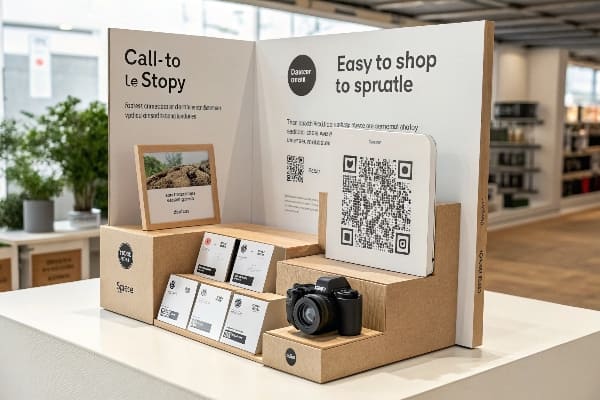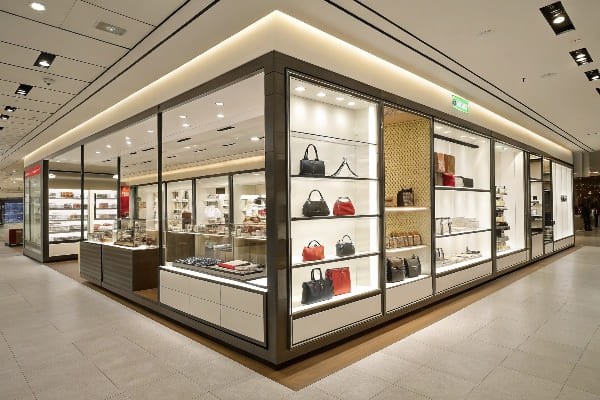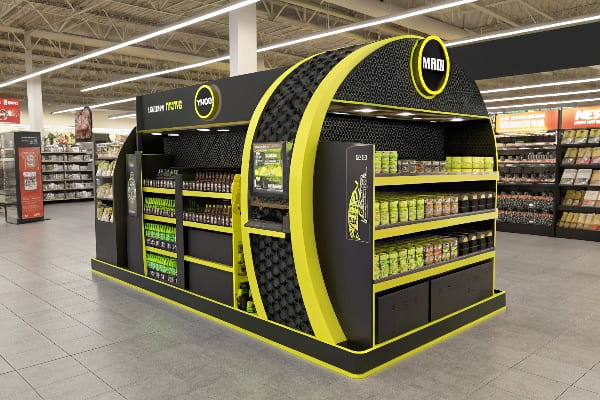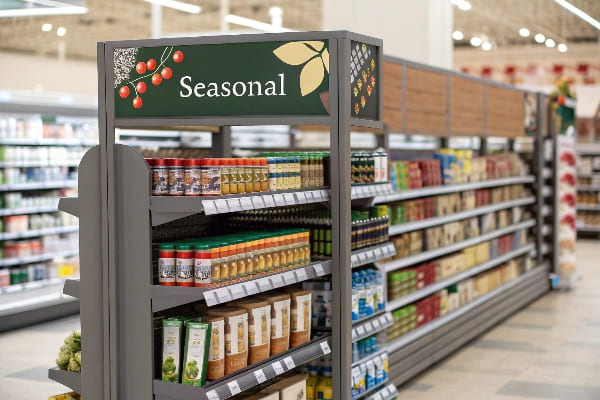A dull display kills sales. It hides value, confuses shoppers, and drains my marketing budget. I need a simple plan that turns cardboard and graphics into a silent salesperson.
A good retail display guides the eye, tells a clear product story, and drives instant action by combining bold hierarchy, tidy organization, and a single call-to-action.

Shoppers still leave if the display only looks “okay.” Stay with me. The steps below break the big idea into bite-size moves I use every week on the factory floor.
How do you make a good retail display?
Shoppers rush, compare, and leave. A weak stand gets ignored, and my client loses the sale. I must fix pain, stir stress, then deliver the cure.
Start with the target shopper, set one goal, sketch a story flow, choose sturdy materials, test sight lines, add a single headline, and remove every extra detail.

1. Begin with the buyer
I picture David, a crossbow engineer1 facing a tight launch date. He needs a stand that holds heavy limbs, keeps bolts safe, and screams “hunt ready.” I ask three questions: Who shops? What moment are they in? What fear blocks the buy? Clear answers shape the display’s frame, color count, and text size.
2. Map touchpoints
I draw a path from ten feet out. First comes motion. Bold shape or arch grabs peripheral vision. At five feet, product takes over. At one foot, specs and QR codes close the loop. Each zone removes one doubt.
3. Turn story into structure
I break the sketch into simple panels. Top header, mid-shelf hero, base stock. I choose E-flute2 for tablets, double-wall for crossbows. I fix corners with hidden “L” locks so staff build it under two minutes. A spare cutout carries extra arrows.
4. Print for contrast
I use two core colors: brand orange and woods-pattern gray. High white text tests at 90+ L* on my press. That keeps copy loud under store LEDs. I load the print run with G7 calibration targets so mass production matches the approved sample.
5. Stress test early
We drop a 15 kg weight on each shelf, then shake the unit for two hours. When glue fails, I swap to tuck tabs. When ink scuffs, I add matte lamination. I film each fix and send a clip to the client. Trust grows.
| Step | Tool | Time | Tip |
|---|---|---|---|
| Buyer profile | Interview | 30 min | Ask one probing “why?” |
| Storyboard | Pen + grid | 20 min | Limit to 3 frames |
| CAD layout | ArtiosCAD | 45 min | Use material library |
| Prototype cut | Sample table | 30 min | Mark weak folds |
| Live test | Vibration bed | 2 hours | Record results |
What are the criteria of a good retail display?
Customers skip displays that fail basic needs. Poor load, glare, or clutter ruins trust. Pain grows. Sales bleed.
A strong retail display meets five tests: stability, visibility, clarity, brand fit, and speed of assembly. Pass all and returns rise.

Stability keeps products safe
Nothing scares a shopper like wobble. I rate each shelf3 by max load × two. I reinforce corners with locking tabs instead of glue so humid air will not loosen joints.
Visibility fights crowd noise
My header must reach eye-level for the target height—about 60 inches for U.S. stores. I angle shelves at 10 degrees up so crossbow cams face forward. Lighting strips add punch but I still favor contrast printing first.
Clarity speeds choice
I cap text at seven words per line. “Ready. Aim. Hunt.” beats a full paragraph. Icons show draw weight, range, and warranty. QR codes4 link to a 30-second demo. Simplicity lowers the mental load.
Brand fit builds trust
I mirror Barnett’s rugged tone. Rough wood graphic sits behind shiny black limbs. My factory’s CMYK press holds deep blacks without banding, a must for premium gear.
Speed of assembly saves cost
Retail staff change often. A display that needs screws dies in store backrooms. I include three numbered flaps and a red “pull” strip. Most units pop in under 90 seconds.
| Criterion | Measure | Target Value |
|---|---|---|
| Load | Static weight/kg | Shelf ≥ 2× product |
| Graphic accuracy | ΔE | ≤ 3 |
| Assembly time | Minutes | < 2 |
| Header height | Inches | 58–62 |
| Fail rate in transit | % | < 1 |
What makes a display attractive?
Crowded aisles fight for eyes. A bland box blends in. My job: trigger instinctive pause, not just polite notice.
Attractive displays use bold contrast, strong shape, sensory texture, motion cues, and clear focus on a single hero product.

Contrast drives first glance
I place neon orange arrows on a charcoal backdrop. The human eye spots edge contrast fast. I test grayscale thumbnails; if shapes pop in gray, colors will sing later.
Shape creates memory
Rounded headers echo a bow’s curve. Die-cut limbs break the rectangle. Memory sticks better when outline differs from shelves around it.
Texture invites touch
Crossbow buyers trust feel. I add soft-touch laminate on grip areas and raised UV on the logo. Shoppers rub the patch, then lift the real bow. Interaction doubles dwell time.
Motion cues lead eyes
Diagonal lines point from header to trigger guard. I sometimes add a slow-blinking LED behind the product, just one, to avoid campy overload. Movement earns a third of a second, enough to read the offer.
Focus prevents overload
One bow, one message. I leave the rest of the family on printed side panels. By removing filler, I turn attention into action.
| Element | Why it works | Quick test |
|---|---|---|
| High contrast5 | Grabs peripheral vision | Squint test |
| Unique silhouette6 | Aids recall | Outline check |
| Tactile layers7 | Builds desire | Finger trace |
| Directed lines | Guides gaze | Eye-tracking |
| Single focal point | Cuts decision time | Five-second scan |
How do retail stores display their merchandise?
Retail real estate costs money per square foot. A sloppy plan wastes rent. I must think like the store manager.
Stores mix end caps, gondolas, dump bins, and countertop stands, arranged by traffic flow data, season, and impulse triggers to lift average basket size.

Zone the floor for missions
Many retailers split the journey into power aisle8, dwell zone, and impulse lane. End caps face the power aisle. They move volume items. My cardboard stand often nests into an end-cap, replacing steel only during the promo window.
Follow the racetrack
Most supermarkets push traffic around a loop. High-margin items sit on the right side of the loop because most shoppers turn right first. I design graphics facing that angle so the logo reads before the shopper steps past.
Tell stories in vertical blocks
Crossbows stack best from light accessories up top to the heavy bow base. Vertical blocks help shoppers read the range quickly. Color blocking also signals brand.
Use eye-level for heavy hitters
Eye-level is buy-level. But some bulky items sit low. I cheat by angling the product face upward. Cardboard risers lift the hero without raising the center of gravity.
Keep checkout lines profitable9
Countertop PDQs carry arrow wax packs and replacement strings. Small, cheap, urgent. They fit a 9-inch square footprint. We produce them flat-packed, ten per shipper.
| Fixture | Best for | Key size |
|---|---|---|
| End cap | High volume | 3 ft × 4 ft |
| Gondola shelf | Category browse | 48 in × variable |
| Dump bin | Bulk impulse | 40 gal |
| Countertop | Add-on sales | 9 in×9 in |
| Floor stand | Themed promo | 18 in×60 in |
Conclusion
Good retail displays whisper value, guide eyes, and remove doubt; follow clear criteria and your cardboard stand will sell while you sleep.
Explore this link to understand the role of a crossbow engineer and their impact on product design and functionality. ↩
Discover the benefits of E-flute in packaging design, especially for lightweight and durable solutions. ↩
Explore this link to discover effective shelf design strategies that enhance product visibility and stability, crucial for retail success. ↩
Learn how QR codes can enhance customer interaction and provide instant access to product information, boosting sales and satisfaction. ↩
Exploring this resource will deepen your understanding of how high contrast can enhance visual appeal and user engagement. ↩
This link will provide insights into the importance of unique silhouettes in creating memorable brand identities. ↩
Discover how tactile elements can influence consumer behavior and enhance product desirability by exploring this resource. ↩
Understanding the power aisle can enhance your retail strategy, maximizing product visibility and sales. ↩
Discover effective strategies to boost impulse purchases at checkout, enhancing overall profitability. ↩

